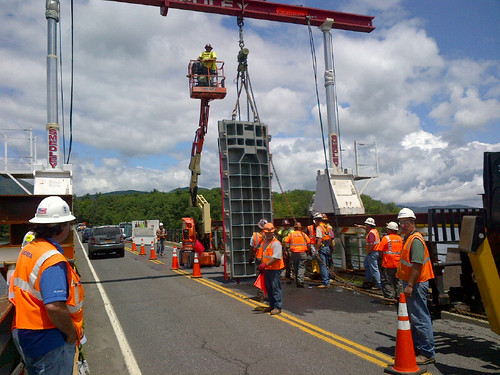FOR IMMEDIATE RELEASE 16-88 September 9, 2016 Contact: deppressoffice@dep.nyc.gov, (845) 334-7868 Department of Environmental Protection Completes Replacement of Gates at Ashokan Dividing Weir$14.1 million project restores full function to Dividing Weir at Ashokan ReservoirThe New York City Department of Environmental Protection (DEP) announced that it has restored full function to the Dividing Weir at Ashokan Reservoir by replacing the four massive cast iron gates that control the flow of water between the reservoir’s two basins. The $14.1 million project allows DEP to move water from the reservoir’s west basin to east basin in a controlled manner. By drawing the west basin down, the new gates will also maximize retention time for water in that portion of the reservoir, which acts as a settling basin for sediment that is washed into the reservoir during heavy runoff events. “As portions of our Catskill Water Supply turn a century old, this project is one of many that New York City will be undertaking to keep our system in a state of good repair,” DEP Acting Commissioner Vincent Sapienza said. “Of the 19 reservoirs in the water supply system, Ashokan was the only reservoir designed with two basins to allow for additional retention and settling time. By replacing these gates, DEP has ensured that this key infrastructure continues to operate as it was designed.” Replacement of the four gates began in 2012 and was completed in 2016. The cast iron sluice gates are each 5 feet wide and 15 feet tall, and each weighs approximately 18,500 pounds. Utilizing a crane, workers lowered each of the new gates through the roadway of the Dividing Weir Bridge and into a chamber situated below the water. Before they were replaced, three of the four original gates were stuck in a closed position, hampering the ability of water supply operators to move water from one basin to the other. The old gates, installed in the early 1900s as part of the original construction of Ashokan Reservoir and its facilities, had been operated by a single motor. The four new gates are operated by individual motors, along with hand-crank backups, to prevent a single point of failure. In addition to the gates, bar racks were installed on the western side of the Dividing Weir to prevent large debris from coming through the weir or slamming into the gates when they are closed. When Ashokan Reservoir was planned during the first decade of the 1900s, engineers designed it with two basins to provide additional retention time that would allow fine sediments to settle out of the water. Pre-construction studies had shown that Ashokan would benefit from this design because its watershed included fine silts and clays that were left behind during the Ice Age when glaciers flowed through the eastern portion of the Catskill Mountains. These fine sediments can be picked up and carried by streams into the reservoir during heavy rain storms, melting snow, or a combination of both. The west basin of the reservoir was designed to capture this water and allow the sediment to settle to the bottom. Once the water clears, the Dividing Weir could move the water into the east basin, which is generally the source of water conveyed to New York City through the Catskill Aqueduct. (When water quality conditions are favorable, DEP often draws drinking water from the west basin or both basins simultaneously.) The full function of the Dividing Weir is key to this process, and the new gates were already helpful this past winter when DEP transferred water between basins ahead of some large rain events. DEP manages New York City’s water supply, providing more than one billion gallons of high quality water each day to more than 9.5 million New Yorkers. This includes more than 70 upstate communities and institutions in Ulster, Orange, Putnam and Westchester counties who consume an average of 110 million total gallons of drinking water daily from New York City’s water supply system. This water comes from the Catskill, Delaware, and Croton watersheds that extend more than 125 miles from the City, and the system comprises 19 reservoirs, three controlled lakes, and numerous tunnels and aqueducts. DEP has nearly 6,000 employees, including almost 1,000 scientists, engineers, surveyors, watershed maintainers and other professionals in the upstate watershed. In addition to its $70 million payroll and $157 million in annual taxes paid in upstate counties, DEP has invested more than $1.7 billion in watershed protection programs—including partnership organizations such as the Catskill Watershed Corporation and the Watershed Agricultural Council—that support sustainable farming practices, environmentally sensitive economic development, and local economic opportunity. In addition, DEP has a robust capital program with over $14 billion in investments planned over the next 10 years that will create up to 3,000 construction-related jobs per year. For more information, visit nyc.gov/dep, like us on Facebook, or follow us on Twitter. | ||
